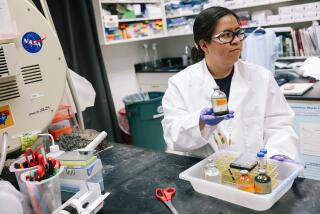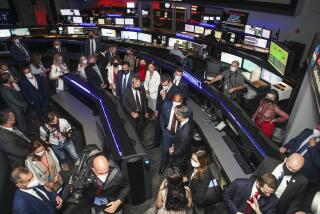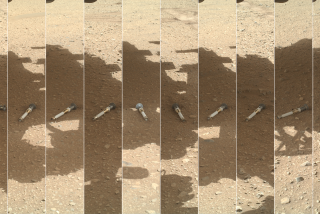New Center Moves JPL to Forefront of Research
- Share via
Weaving around a computer crammed into a poorly lit corner and ducking under wires attached to something called a scanning tunneling microscope, Carl Kukkonen was getting flustered.
“Watch out, you have to kind of . . . that’s it, that way,” he said, navigating around million-dollar pieces of equipment squeezed into a 30-year-old laboratory building. “Sorry. It’s a zoo in here.”
It’s a mess these days in Lab No. 189 at the Jet Propulsion Laboratories in La Canada Flintridge. But it won’t always be that way because JPL has just dedicated a 3-story laboratory and office building that will provide a spacious home for the millions of dollars of state-of-the-art equipment now sharing cramped quarters in several buildings at the complex.
In the next 3 months, the accelerometers and sensors, the photovoltaic solar cells and superconductors, the electron beam lithography instrument and the microscopes will be moved. The 60 scientists and researchers who will staff the center will begin working. And the new Microdevices Laboratory Building, planned more than 4 years ago and built and equipped at a cost of $24.4 million, will be complete.
The scientists, about 18 of whom have been hired over the past two years as JPL prepared to open the center, will finally have the space and flexibility that their work demands. Perhaps most important, they will be working on more sophisticated equipment.
Kukkonen is the new director of the program to be housed in the building--the Center for Space Microelectronics Technology. The center is JPL’s response to a need for research and development into equipment so specialized that private industry has not found it feasible to explore.
“If private labs tell us it’s just too costly to build, well, we’ll do it ourselves,” he said. “If a $1-million piece of equipment allows us to do one more thing, to get new data, to visit one new planet, it’s worth it.”
Once a device created and developed by the Microdevices Laboratory is proven, it will be turned over to private industry for production, Kukkonen said. The center’s work is unclassified, and arrangements have been made for the center to be used by researchers from major universities in Southern California.
The center is paid for by the U.S. Department of Defense, the Strategic Defense Initiative Organization, the Army, the Navy, the Air Force and the Department of Energy. Kukkonen said the heavy hitters are involved because of their interest in JPL’s work in the new facility--research to make computer chips faster and more complex, to make robots that think and computers that learn.
No West Coast laboratory exists with adequate facilities to do the kind of work JPL researchers will do at the Microdevices Laboratory, Kukkonen said.
Electron Beam Lithography
There are three other laboratories in the country that can do electron beam lithography, he said. One is at Cornell University in New York, one is at AT&T; Bell Laboratories in New Jersey and one is at the University of Michigan at Ann Arbor.
On a recent tour of the new facility, Kukkonen stopped in front of an artist’s rendering of a satellite in space. Pointing to the center of the tip of one arm of the satellite, he summed up perhaps the most amazing thing about the work to be done at the center:
“Everything we will make in this building will fit right here,” he said. “And without it, the satellite is no use.”
Central to the plans that JPL and its backers have for the center are a series of rooms on the first floor of the building. The white spaces without windows and with doors made of thick glass are “clean rooms,” carefully maintained environments where the air will be as much as 1 million times purer than the Los Angeles atmosphere.
In the clean rooms, scientists covered in white “bunny suits” to avoid contaminating the atmosphere will operate an electron beam lithography instrument--a device that, simply put, shoots electron beams onto a computer chip to form circuit patterns more than 50 times smaller than the smallest chips in production. And it is there where scientists also hope to manufacture neural networks--computer chips that will emulate the functions of the human brain.
3 New Buildings
The center is one of three new buildings built at JPL--a division of Caltech operated for the National Aeronautics and Space Administration as a center for space research--over the last two years.
The center is part of a 5-year plan to modernize facilities that were to be temporary when first built after World War II. Somehow, Kukkonen said, the facilities became permanent. Much of the equipment that will be used in the center is already being used by scientists at JPL, but because of the outmoded facilities, Kukkonen said scientists who should be working together almost never see each other, thus slowing progress on research.
Kukkonen is excited about the idea of bright people working together to solve the puzzles of space.
“Inventions are made over coffee, when people are working together,” he said. “The synergism of their ideas is in a way just as important as the idea itself.”
More to Read
Sign up for Essential California
The most important California stories and recommendations in your inbox every morning.
You may occasionally receive promotional content from the Los Angeles Times.










